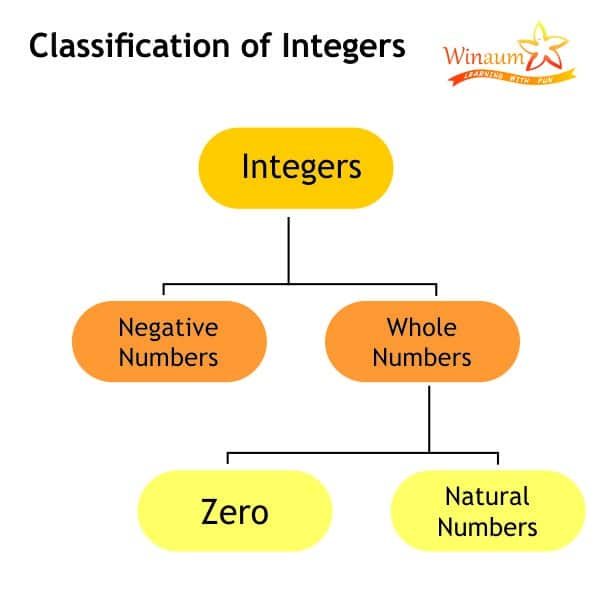
Table of Contents
Integers and its Properties
There are several properties of integers knowing which we can understand their operations. Integers are a group of natural numbers, negative numbers, and the number 0. We can say that all the whole numbers and negative numbers together form integers. Integers are demoted by Z.
Properties of Integers
- Closure Property
- Commutative Property
- Associative Property
- Distributive Property
- Identity Property
Closure Property of Integers
In the different properties of integers that are there, the Closure Property of Integers says that the sum or difference of integers is always an integer.
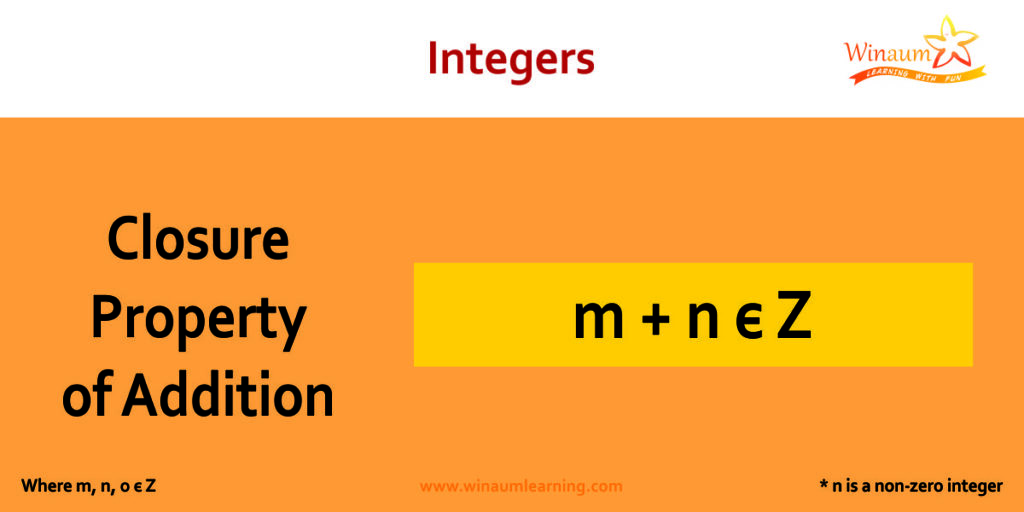
Closure Property of Addition:
The addition of the two integers will always give a result that is also an integer. In other words, the answer of two addends which are integers is also an integer.
General Property: For all m, n belongs to Z, m + n belongs to Z
Example 1: Let m = 3 and b = (-5)
=> 3 + (-5) = (-2) [ integer ]
Here -2 is an integer.
Example 2 :Let m = 11 and n = (-8)
=> 11 + (-8) = 3 [ integer ]
Here 3 is an integer.
Example 3: Let m = 56 and n= (-68)
=> 56 + (-68) = (-12) [ integer ]
Here 12 is an integer.
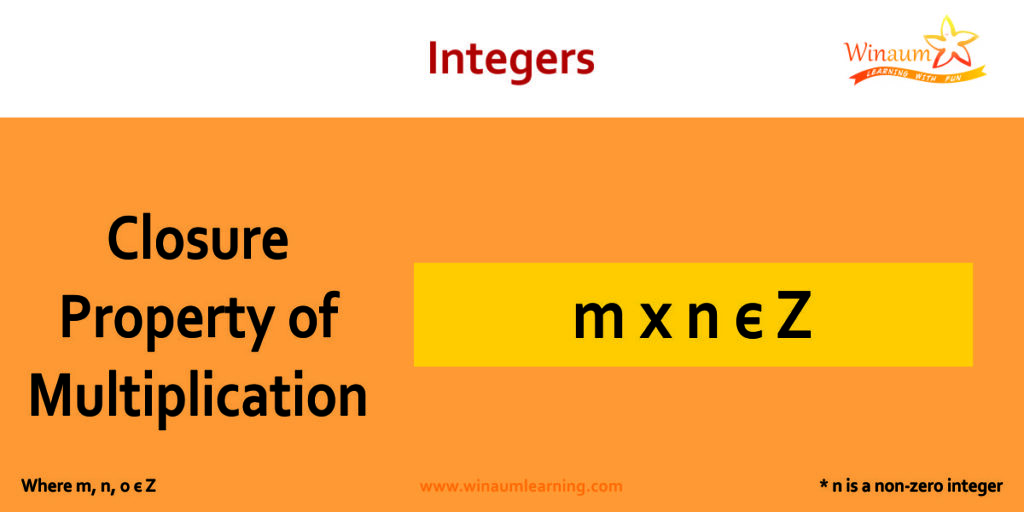
Closure Property of Multiplication:
The multiplication of the two integers will always give a result that is also an integer. The product of two integers will always lead to an answer which is an integer.
General Property: For all m, n belongs to Z , m × n belongs to Z
Example 1 : Let m = 18 and n = (-11)
=> 18 × (-11) = (-198) [ integer]
Hence, The result of multiplication for the two integers 18 and -11 is also an integer -198.
Example 2 : Let m = 60 and n= (-70)
=> 60× (-70) = (-4200) [ integer ]
Example 3: Let m = 15 and n = 6
15 × 6 = 90 [ integer ]
Hence, The result of multiplication for the two integers 15 and 6 is also an integer 90.
Conclusion: Hence as per the Closure Property of Integers: For all m, n belongs to Z , m+ n belongs to Z and m × n belongs to Z. Therefore, we can conclude that integers are closed under addition and multiplication. To understand more on the Closure Property of Integers, join Winaum Learning Math Classes where teachers teach students with individualized attention. Book a Free Trial.
Associative Property of Integers
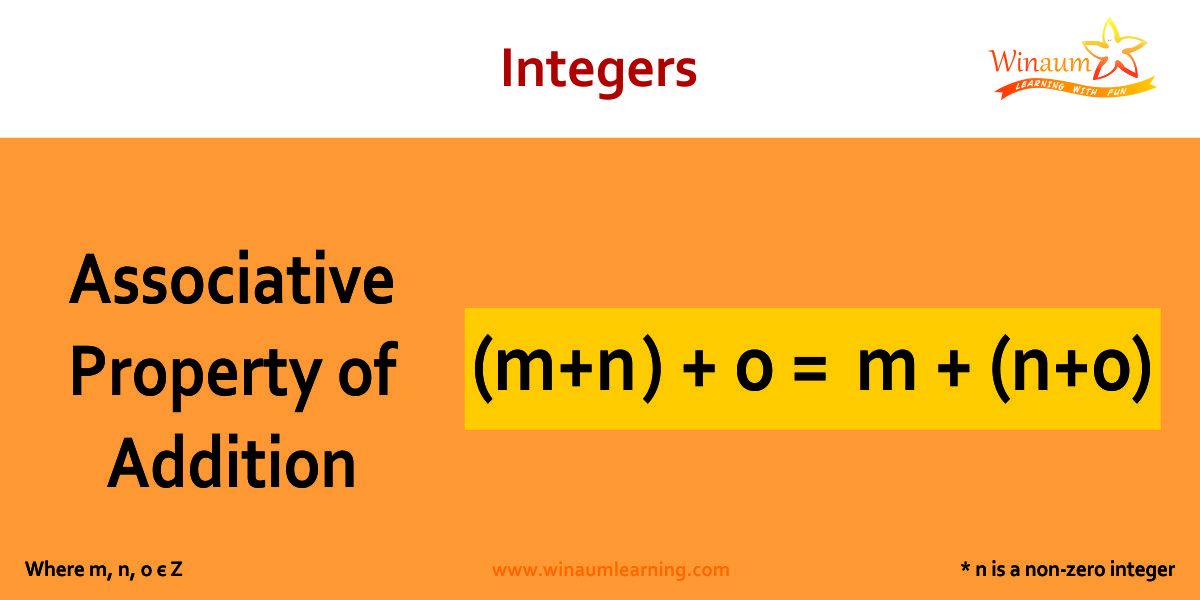
Associative Property of Addition
In the different properties of integers that are there, the Associative Property of Integers for Addition says the result of the addition of the three integers will be the same, no matter in which sequence they’re added. The sum of three integers will be equal irrespective of the order they’re added to each other.
General Property: For all l, m, n belongs to Z
(l + m) + n = l + (m + n)
For example:
- Let l =(-18), m = 12 and n = 10
[ (-18) + 12 ] + 10 = (-18) + ( 12 + 10 )
(-6) + 10 = (-18) + 22
4 = 4
LHS = RHS
- Let l = 16, m = 7 and n = (-30)
(16 + 7) + (-30) = 16 + [ 7 + (-30)]
23 + (-30) = 16 + (-23)
(-7) = (-7)
LHS = RHS
- Let l = 190, m = (-80) and n = (-25)
[190 + (-80)] + (-25) = 190 + [(-80) + (-25)]
110 + (-25) = 190 + (-105)
85 = 85
LHS = RHS
- Let l = 102 , m = 50 and n = (-200)
(102 + 50) + (-200) = 102 + [50 + (-200)]
- + (-200) = 102 + (-150)
- = 48
LHS = RHS
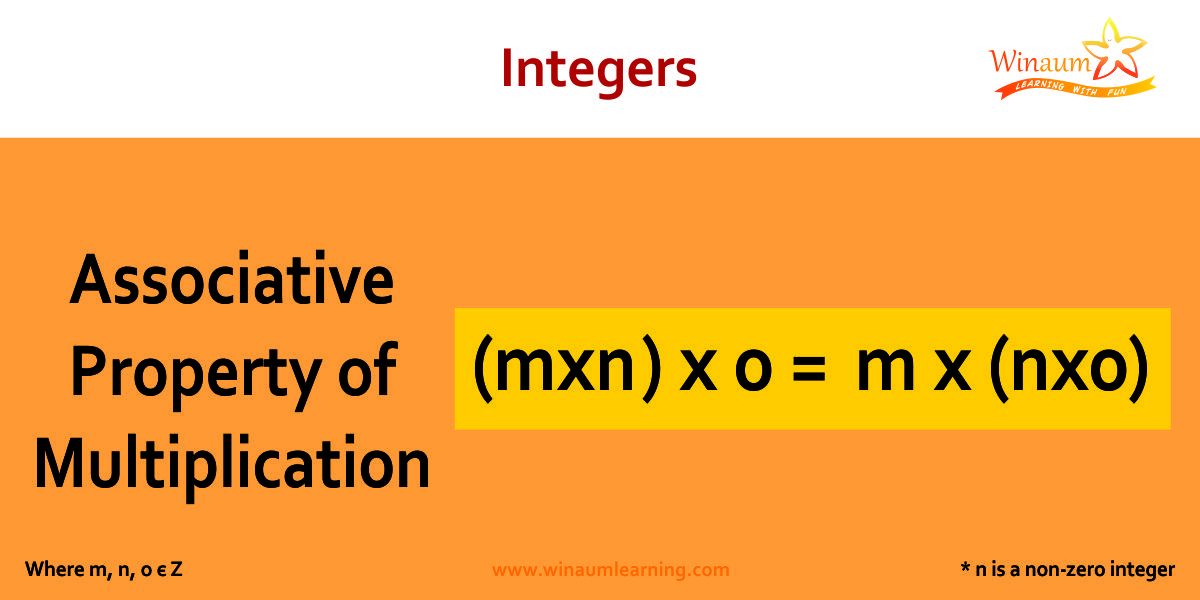
Associative Property of Multiplication:
The result of the multiplication of three integers will be the same irrespective of the order they’re multiplied by each other. The product of three integers will be the same, no matter whatever will be the sequence of multiplication.
General Property: For all l, m, n belongs to Z
(l × m) × n = l × (m × n)
- Let l =4, m = (-2) andn = 3
[4 × (-2)] × 3 = 4 × [(-2) × 3]
(-8) × 3 = 4 × (-6)
(-24) = (-24)
LHS = RHS
- Let l = 6, m = (-7) andn = (-2)
[6 × (-7)] × (-2) =6 × [(-7)× (-2)]
(-42) × (-2) = 6 × 14
- 84
LHS = RHS
- Let l = 80, m = (-5) andn = 3
[80 × (-5)] × 3 = 80 × [(-5) × 3]
(-400) × 3 = 80 × (-15)
(-1200) = (-1200)
LHS = RHS
- l = (-4), m = 12 and n = 8
[ (-4) × 12 ] × 8 = (-4) × (12 × 8)
(-48) × 8 = (-4) × 96
(-384) = (-384)
LHS = RHS
General Property: For all l, m, n belongs to Z
(l + m) + n = l + (m + n)
and
(l × m) × n = l × (m × n)
Therefore, we can conclude that integers are associative under addition and multiplication.
Commutative Property of Integers
Among the properties of integers that are there, the Commutative Property of Integers says that the sum or multiplication of integers is always an integer even if the order is different.
Commutative Property of Addition
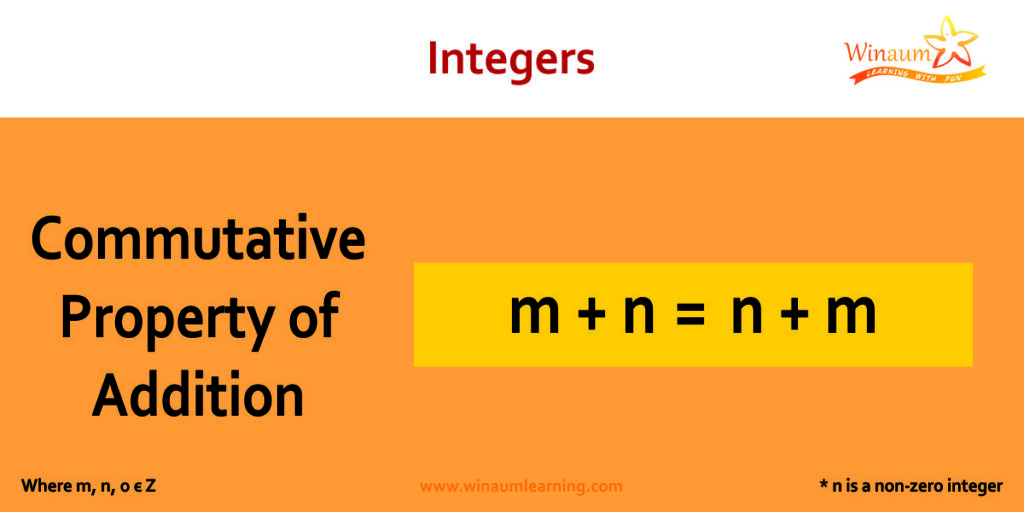
The sum of two integers always remains the same even if the order of the numbers gets changed. If we add the first integer to the second one or we add the second integer to the first one the answer will be the same in both cases.
General Property: For all m, n belongs to Z
m + n = n + m
For example:
- Let m = 6 and n =(- 9)
6 + (- 9 ) = (-9)+ 6
(-3) = (-3)
LHS = RHS
- Let m = 15 andn = (-6)
- + (-6) = (-6) + 15
9 = 9
LHS = RHS
- Let m = 66 and n = (-12)
66 + (-12) = (-12) + 66
- = 54
LHS = RHS
- Let m = 100 and n = (-89)
- + (-89) = (-89) + 100
- = 11
LHS = RHS
Commutative Property of Multiplication
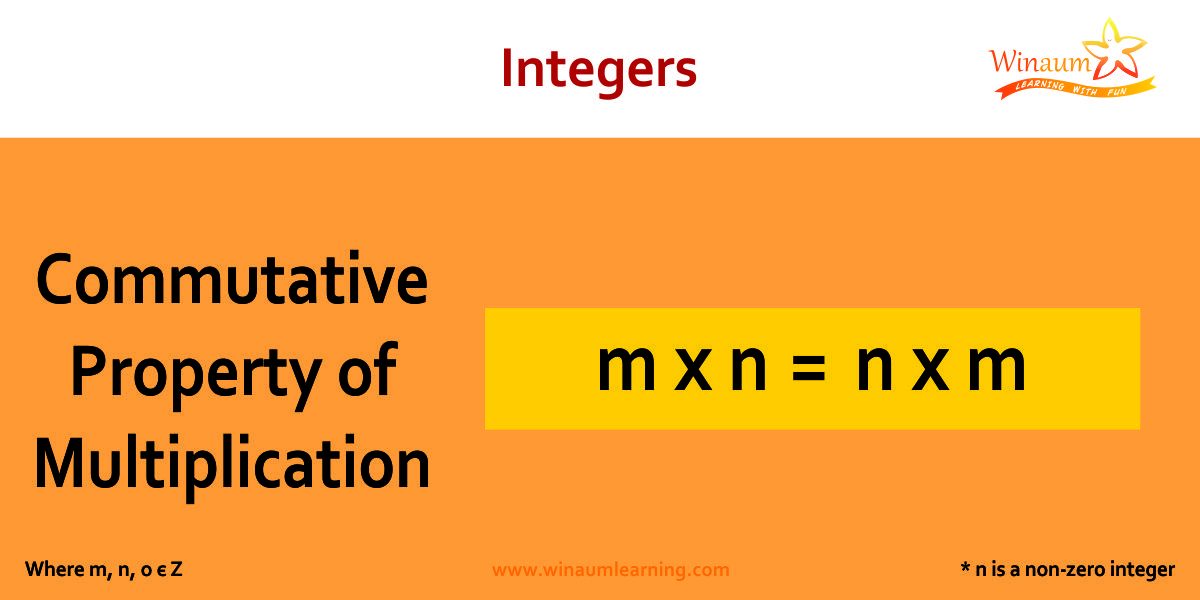
The product of two integers will give the same result if we add the first number to the second or vice versa. In other words, whenever the two integers are multiplied the product will be equal irrespective of the order they were multiplied.
General Property: For all m, n belongs to Z
m × n = n × m
For example:
- Let m = 11 andn = (-3)
11 × (-3) = (-3) × 11
(-33) = (-33)
LHS = RHS
- Let m = 5 and n= (-6)
5 × (-6) = (-6) × 5
(-30) = (-30)
LHS = RHS
- Let m = 80 andn = 15
80 × 15 = 15 × 80
1200 = 1200
LHS = RHS
- Let m= (-22) andn = 70
(-22) × 70 = 70 × (-22)
(-1540) = (-1540)
LHS = RHS
General Property:For all a, b belongs to Z
m + n = n + m
and
m × n = n × m
Therefore, integers are definitely commutative in terms of addition and multiplication.
Identity Element of Integers:
Identity Element of Addition:
If 0 is added to an integer, the answer will be the number itself. We can say that if an integer and 0 are added to one another, it leads to the result which is that integer itself.
Property: For all m belongs to Z
m + 0 = m (integer itself)
For example:
- (-32)+ 0 = (-32) (integer itself)
- 76 + 0 = 76 (integer itself)
- (-48) + 0 = (-48) (integer itself)
Identity Element of Multiplication:
If any integer is multiplied by 1, we will get the same integer as an answer. The product of any integer and 1 gives a result which is that integer itself.
General Property: For all m belongs to Z
m × 1 = m
For example:
- (-95)× 1 = (-95) (integer itself)
- 52 × 1 = 52 (integer itself)
- (-66) × 1 = (-66) (integer itself)
Distributive Property of Integers
Distributive Property of Multiplication over Addition:
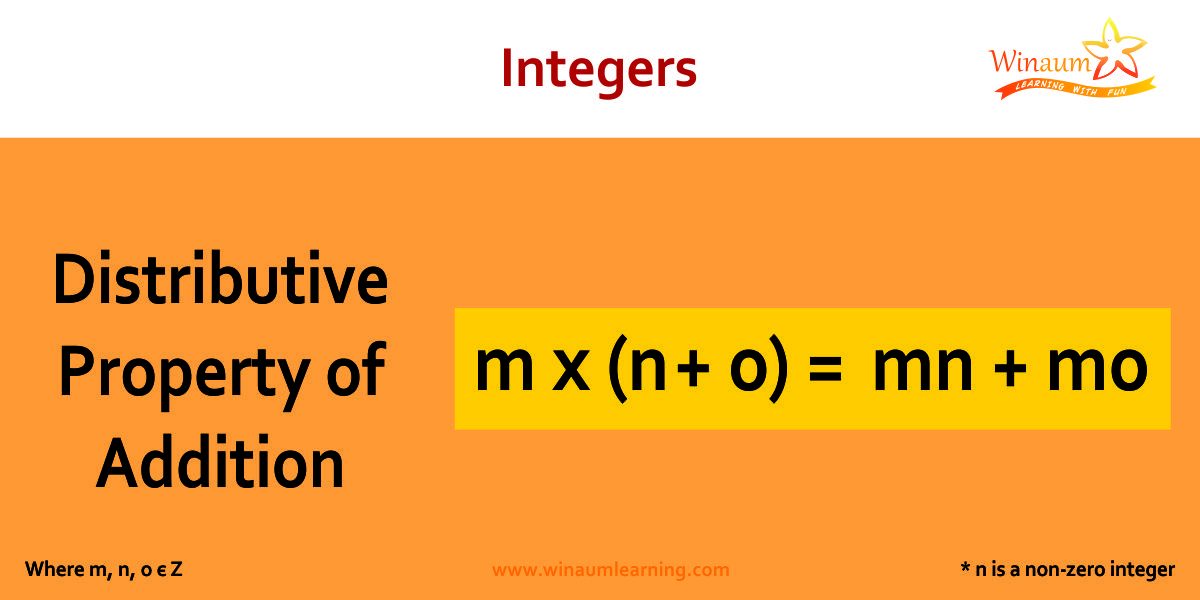
If an integer is multiplied by the sum of two integers, the result will be the same if the same integer is multiplied by both the integers one by one and then added to each other.
General Property: For all l, m and n belongs to Z
l × (m + n) = (l × m) + (l × n)
For example:
- Let l =(-7), m = 8 andn = 3
(-7) × (8+3) =[(-7) × 8]+ [(-7) × 3]
(-7) × 11 = (-56) + (-21)
(-77) = (-77)
LHS = RHS
- Let l = 10, m = (-6) and n = 5
10 ×[(-6) + 5] = [10×(-6) + 10×5]
- (-1) = (-60) + 50
(-10) = (-10)
LHS = RHS
- Let l = 15, m = 6 and n = (-8)
- × [6 + (-8)] = (15 × 6) + [15 × (-8)]
15 × (-2) = 90 + (-120)
(-30) = (-30)
LHS = RHS
- Let l = 36, m = 19 and n = (-4)
36 × [19 + (-4)] = (36 × 19) + [36 × (-4)]
36 × 15 = 684 + (-144)
540 = 540
LHS = RHS
Distributive Property of Multiplication over Subtraction:
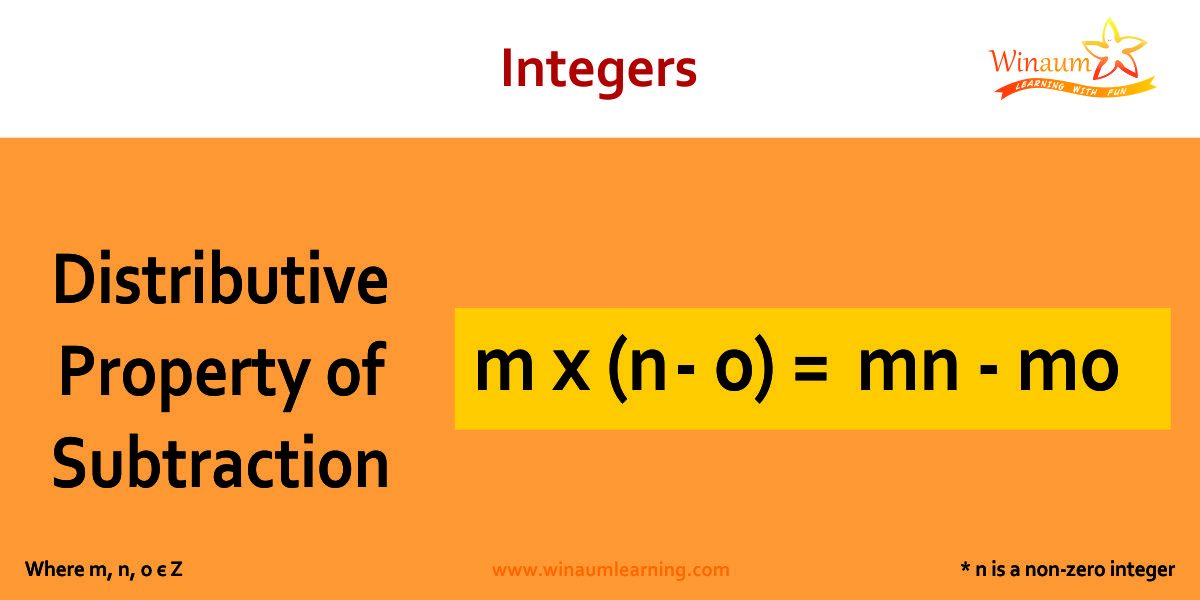
If an integer is multiplied by the difference of two integers, the result will be the same if the same integer is multiplied by both the integers one by one and then the difference is calculated.
General Property: For all l, m and n belongs to Z
l × (m – n) = (l × m) – (l × n)
For example:
- Let a = 12, b = (-5) and c = 6
12 × [(-5) – 6] = [12 × (-5)] – (12 × 6)
12 × (-11) = (-60) – 72
(-132) = (-132)
LHS = RHS
- Let l = 15, m = (-9) and n = (-11)
15 × [(-9) – (-11)] = [15 × (-9)] –[15 × (-11)]
15 × [(-9) + 11] = (-135) – (-165)
15 × 2 = (-135) + 165
30 = 30
LHS = RHS
- Let l = 40, m= 22 and n = (-8)
40 × [22 – (-8)] =(40 × 22) –[40 × (-8)]
40 × (22 + 8) = 880 – (-320)
40 × 30 = 880 + 320
1200 = 1200
LHS = RHS
- Let l= 65, m = 10 and n = (-3)
65 × [10 – (-3)] = (65 × 10) – [65 × (-3)]
65 × (10 + 3) = 650 – (-195)
65 × 13 = 650 + 195
845 = 845
LHS = RHS
Important Points to Remember for Properties of Integers
- All the whole numbers are integers but all the integers are not whole numbers.
- All the natural numbers are integers but all the integers are not natural numbers.
- Integers can be positive or negative.
- All the integers are closed under addition and multiplication.
- Integers are associative as well as commutative for addition and multiplication.
